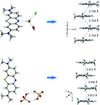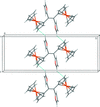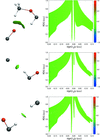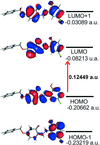issue contents
May 2018 issue
Special issue on Weak interactions in crystals: an integrated approach
Editors: Chiara Massera and Helen Stoeckli-Evans

Cover illustration: Two unprecedented salts of methylene blue (MB+), namely MB chloride dihydrate, C16H18N3S+·Cl-·2H2O and MB bisulfite, C16H18N3S+·HSO4- have been obtained and structurally characterized. The stacking geometry differs between the two phases and is influenced by the presence (or absence) of the lattice water molecules, in combination with the cationic nature of the organic molecule. This difference has been analysed and rationalized by means of Hirshfeld surface analysis. See: Canossa, Predieri & Graiff [Acta Cryst. (2018). E74, 587-593].
editorial
Chiara Massera and Helen Stoeckli-Evans introduce this special issue of Acta Crystallographica Section E on `Weak interactions in crystals: an integrated approach' where the contributions serve as an excellent introduction to the importance and the interest these have been acquiring in the scientific arena over the last two decades or so.
weak interactions in crystals
Andrei Batsanov presents a general review of weak interactions in crystals, which highlights the history, state-of-the art and future developments of this field.
Download citation


Download citation


The crystal structure of a supramolecular lithium complex of p-tert-butylcalix[4]arene has been determined and analyzed. Different from the majority of calixarene–alkali metal complexes, which are formed by direct coordination of the metal cation to the calixarene hydroxy groups, this complex is stabilized by an interplay of weak interactions involving the methanol molecules surrounding the metal, giving rise to a second-sphere coordination supramolecular assembly.
CCDC reference: 1563055
Download citation


Download citation


Hydrogen-bonded ladders typically encountered in ammonium carboxylate salts did not form in the presence of a pyridine acceptor group.
Download citation


Download citation


Two unprecedented solid phases of methylene blue (MB+), viz. 3,7-bis(dimethylamino)phenothiazin-5-ium chloride dihydrate and 3,7-bis(dimethylamino)phenothiazin-5-ium bisulfite, have been obtained and structurally characterized. The effective absence of hydrogen-bond donors in the second compound has important consequences on the stacking geometry and supramolecular interactions of the MB+ ions, which are analysed by Hirshfeld fingerprint plots.
Download citation


Download citation


The superstructure of 4-(9-methyloxycarbonylnonyloxy)phenylphenol is dominated by O—H⋯O and C—H⋯O hydrogen-bonding and C—H⋯π interactions. Hirshfeld surface, fingerprint plot, interaction energy and energy framework analyses were used to explore the nature and strength of the intermolecular interactions.
CCDC reference: 1586244
Download citation


Download citation


The complex [CoL2Cl2] (L = imidazo[1,2-a]pyridine) exhibits a supramolecular-layered assembly through π–π stacking interactions. The overall intermolecular interactions involved in the structure have been quantified and fully described by Hirshfeld surface analysis.
CCDC reference: 1583014
Download citation


Download citation


In this present study, the crystal structure of 2,2,2-trifluoroacetophenone (TFAP) is determined using in situ cryocrystallization techniques. The main objective of this work is to study its crystal packing associated with the various intermolecular interactions, along with a detailed comparison with the features of substituted analogs. It is interesting to note how the chemical substitution of different functional groups influences the crystal packing, the electronic environment of the molecule and the nature of the various intermolecular interactions.
CCDC reference: 1578858
Download citation


Download citation


The quality of structural models for 1,2,4,5-tetrabromobenzene (TBB), based on data collected from a single crystal in a diamond anvil cell at 0.4 GPa in situ using two different diffractometers belonging to different generations have been compared, alongside the effects of applying different data-processing strategies.
research communications
Download citation


Download citation


The crystal structures of [IrIII(CO)(C(dppm)2-κ3P,C,P′)ClH]Cl and [IrIII(CO)(CH(dppm)2-κ3P,C,P′)ClH]Cl2 have been determined. Both complexes show a slightly distorted octahedral coordinated IrIII centre. The PCP pincer ligand system is arranged in a meridional manner.
Download citation


Download citation


The title compound is the product of a new synthetic route towards tetraaryl/hetaryl-substituted ethenes that reduces the occurrence of side-products. In the crystal, the molecule is centrosymmetric and the cyclopentadienyl rings are nearly coplanar and aligned slightly closer to a staggered conformation than to an eclipsed one.
CCDC reference: 1833400
Download citation


Download citation


The metal coordination geometry in each of the title molecules, [Sn(C6H5)3(C8H16NS2)] (I) and [Sn(C6H5)3(C10H12NOS2)] (II), is based on a heavily distorted tetrahedron owing to the asymmetric mode of coordination of the dithiocarbamate ligand. The persence of C—H⋯π(phenyl) interactions in the crystals lead to dimeric aggregates in (I) and supramolecular chains (II).
Download citation


Download citation


There are alternating relatively strong and weak intermolecular π–π interactions between adjacent pyrene ring systems, forming a one-dimensional supramolecular structure. The compound is weakly fluorescent in THF solution, but it is highly emissive in the condensed phase, revealing distinct aggregation-induced emission (AIE) characteristics.
CCDC reference: 1834096
Download citation


Download citation


The asymmetric unit of the title complex comprises a supramolecular dimer composed of the Δ(−) and Λ(−) optical isomers, which are linked by strong hydrogen-bonds, two nitrate anions and one water molecule. In the crystal, the dimers are joined by numerous hydrogen bonds, forming a three-dimensional framework.
CCDC reference: 1834549
Download citation


Download citation


The A2[ReF6] (A = K, Rb, Cs) salts are isotypic and crystallize in the K2[GeF6] structure type.
Download citation


Download citation


Two new anthracene chalcones, namely 1-(anthracen-9-yl)-3-(naphthalen-2-yl)prop-2-en-1-one and 1-(anthracen-9-yl)-3-(pyren-1-yl)prop-2-en-1-one, have been successfully synthesized and the effect of the different fused ring substituent system attached to the anthracene chalcone derivative investigated. These compounds show a very narrow band gap due to the large p-conjugated systems, making them promising candidates as optoelectronic materials. Hirshfeld surface analysis has been carried out to show the contribution of intermolecular contacts and weak interactions to supramolecular stabilization.
Download citation


Download citation


In the crystal structure of the title compound, C6H10N3O+·C7H4ClO2−, the pyrimidine N atom of the cation is hydrogen-bonded to the 4-chlorobenzoate anion through a pair of N—H⋯Ocarboxyl hydrogen bonds, forming an  (8) ring motif which is linked through centrosymmetric
(8) ring motif which is linked through centrosymmetric  (8) ring motifs, forming a pseudotetrameric DDAA array.
(8) ring motifs, forming a pseudotetrameric DDAA array.
CCDC reference: 1835970
Download citation


Download citation


In the crystal structure of the title compound, a dispiro[indoline-3,2′-pyrrolidine-3′,6′′-isoquinoline]-2,5′′-dione, C—H⋯O hydrogen bonding predominates, linking molecules to form chains propagating along [100].
CCDC reference: 1835595
Download citation


Download citation


In the anhydrate crystal of diammonium aquabis(malonato)oxidovanadate(IV), (NH4)2[VO(C3H2O4)2(H2O)], two conformers (syn or anti conformation on the equatorial plane) of complex cations are detected. The DFT calculations for the isomers indicate a slight influence of the conformation on their thermodynamic stability. The anionic complexes interact with adjacent anions and counter-cations through hydrogen bonds, and the hydrogen bonds lead to a structure with alternate stacking of layers consisting of either anti or syn isomers.
CCDC reference: 1836312
Download citation


Download citation


The crystal structure of bis(tri-2-pyridylamine)iron(II) bis(perchlorate) has been redetermined, and that of the isotypic bis(tri-2-pyridylamine)nickel(II) bis(perchlorate) complex has been rerefined. In each case, the perchlorate anion is disordered over four sets of atomic sites, and the ions are linked by C—H⋯O hydrogen bonds to form a supramolecular three-dimensional framework.
Download citation


Download citation


Two compounds arose from the same reaction in methanol and the other arose from an unexpected reaction with the acetone solvent.
Download citation


Download citation


The main motif within the structure is a lamotrigine dimer stabilized by two ethanol molecules. Here the lamotrigine dimer forms using amines in the ortho position of the triazine group.
CCDC reference: 1826282
Download citation


Download citation


The title Schiff base compound was synthesized via the condensation reaction of 1,2-diaminebenzene with 4-benzyloxy-2-hydroxybenzaldehyde. The molecule is V-shaped and possesses mirror symmetry; the mirror bisects the central benzene ring. There are two intramolecular O—H⋯N hydrogen bonds present forming S(6) ring motifs.
CCDC reference: 1837095
Download citation


Download citation


The title compound is a flexible Schiff base, as illustrated by its dihedral angles. The sp2-hybridized character of the azanylylidene groups is confirmed by their bond lengths and bond angles. In the crystal, molecules of the title compound are assembled into two-dimensional networks connected by weak C—H⋯O, C—H⋯N and C—H⋯π intermolecular interactions.
CCDC reference: 1435817
Download citation


Download citation


The binuclear CuII complex displays a paddle-wheel structure. In the crystal, adjacent DMF molecules coordinated to copper atoms are arranged in a mutual `head-to-tail' manner by offset face-to-face π–π stacking interactions, resulting in chains along the c-axis direction. These are assembled into a three-dimensional structure by further weak C—H⋯O and C—H⋯π interactions involving the DMF solvent molecules.
CCDC reference: 1837401
Download citation


Download citation


The bulky tert-butyl groups of the dbbpy ligand do not preclude the formation of head-to-head dimers in the crystal structure of bis(acetonitrile)(4,4′-di-tert-butyl-2,2′-bipyridine)platinum(II) tetrafluoridoborate.
CCDC reference: 1837532
Download citation


Download citation


Strontium and barium acesulfames crystallize in nearly identical isotypic forms, with barium–oxygen interatomic distances being longer due to the larger ionic radius of the barium(II) ion. The conformation of the acesulafame ions is a distorted envelope with an out-of-plane S atom. Metal and acesulfame ions are assembled in infinitive chains along the [100] axis. These chains are connected via hydrogen bonds into a three-dimensional network.
Download citation


Download citation


A chiral methine-C atom connects the (4-chlorophenyl)sulfanyl, benzaldehyde and methoxy residues in the racemic title compound. Supramolecular helical chains are formed in the crystal, being sustained by methyl- and methine-C—H⋯O(carbonyl) interactions.
CCDC reference: 1838590
Download citation


Download citation


The title compound is essentially planar, with an r.m.s. deviation of 0.054 Å. The molecular structure is fixed in the azo tautomer by intramolecular C—H⋯N interactions, with O—H⋯O hydrogen bonds creating linked dimers. Charge-transfer interactions are observed, with the segregated stacks linked by Br⋯Br interactions.
CCDC reference: 1838908
Download citation


Download citation


In the crystal of the title compound, molecules are linked by C—H⋯O hydrogen bonds, forming C(11) helical supramolecular chains along the 21 axis running parallel to [100].
CCDC reference: 1837011
Download citation


Download citation


The conformation of the title diaminopyrimidine sulfanly acetamides, (I) and (II), have similar conformations, with the pyrimidine ring being inclined to the pyridine ring in (I) by 71.10 (9) °, and by 62.93 (15) ° to the pyrazine ring in (II).
Download citation


Download citation


The preparation and the crystal structure of octane-1,8-diaminium 4,4′-azinodibenzoate monohydrate are reported.
CCDC reference: 1839024
Download citation


Download citation


The title compound, (4bS,8aR)-1-isopropyl-4 b,8,8-trimethyl-7-oxo-4 b,7,8,8a,9,10-hexahydrophenanthren-2-yl acetate, was prepared by a direct acetylation reaction of naturally occurring totarolenone. In the crystal, molecules are linked to each other by C—H⋯O hydrogen bonds and C—H⋯π interactions, forming sheets parallel to the bc plane.
CCDC reference: 1835842
Download citation


Download citation


In the title MnI and ReI complexes of the ligand 2-(2,2′-bipyridin-6-yl)benzoic acid, the o-benzoic acid substituent does not coordinate to the metal. In fac-[2-(2,2′-bipyridin-6-yl)benzoic acid-κ2N,N′]tricarbonylchloridorhenium(I) tetrahydrofuran monosolvate, the benzoic acid fragment is positioned near the axial carbonyl ligand, whereas in fac-[2-(2,2′-bipyridin-6-yl)benzoic acid-κ2N,N′]bromidotricarbonylmanganese(I) tetrahydrofuran monosolvate, the benzoic acid fragment is disordered, such that in the major component the benzoic fragment is positioned near the bromide ligand and in the minor fragment near the axial carbonyl ligand.
Download citation


Download citation


The synthesis and structures of (E)-2-{[(2-aminophenyl)imino]methyl}-5-(benzyloxy)phenol (I) and (Z)-3-benzyloxy-6-{[(5-chloro-2-hydroxyphenyl)amino]methylidene}cyclohexa-2,4-dien-1-one (II) are reported. The crystal structures of the molecules are stabilized by N—H⋯O, O—H⋯O and C—H⋯π contacts. DFT calculations on the structure of (II) support the Keto–imine tautomeric form found in the solid state structure. The antioxident properties of both molecules are investigated.
Download citation


Download citation


The asymmetric unit contains two independent molecules, which are linked by an O—H⋯O hydrogen bond. The dimers are further assembled into one-dimensional ladder like structure through O—H⋯F hydrogen bonds and stabilized by π–π interactions. The ladders are further linked by C—H⋯π contacts.
CCDC reference: 1839158
Download citation


Download citation


In the crystal, pairs of molecules are linked by N—H⋯O and C—H⋯O hydrogen bonds, forming inversion dimers with graph-set notation  (8) and
(8) and  (11), which are connected by C—H⋯O hydrogen-bonding interactions into ribbons parallel to (100). The ribbons are further connected into a three-dimensional network by C—H⋯π interactions and π–π stacking interactions between benzene and the thiophene rings.
(11), which are connected by C—H⋯O hydrogen-bonding interactions into ribbons parallel to (100). The ribbons are further connected into a three-dimensional network by C—H⋯π interactions and π–π stacking interactions between benzene and the thiophene rings.
CCDC reference: 1839201
Download citation


Download citation


The Br− anion is linked to the cation by an N—H⋯Br hydrogen bond. C—H⋯O hydrogen bonds link adjacent pyridiniminium cations into inversion dimers with an  (18) graph-set motif. These dimers are stacked in a phenyl–phenyl T-shaped geometry through C—H⋯π interactions.
(18) graph-set motif. These dimers are stacked in a phenyl–phenyl T-shaped geometry through C—H⋯π interactions.
CCDC reference: 1839059
Download citation


Download citation


One of the nine-membered 2,3-dihydro-1,3-benzoxazole rings and the phenyl ring are almost parallel to each other, making a dihedral angle of 5.30 (18)°. These rings are almost normal to the mean plane of the other nine-membered 2,3-dihydro-1,3-benzoxazole ring. The crystal structure features C—H⋯O hydrogen bonds and π–π stacking interactions.
CCDC reference: 1838126
Download citation


Download citation


The structure of a coumarin ester stabilized by C—H⋯O hydrogen bonds and C=O⋯π and π–π stacking interactions has been studied by X-ray diffraction, Hirshfeld surface analysis and quantum chemical calculations.
CCDC reference: 1834035


 journal menu
journal menu


























































